University Of Texas At Dallas
-
- Bluefin Robotics on the Hunt for MH370 Marine Technology, May 2014 #18
When Malaysian Airlines flight 370 disappeared on March 8, 2014 with 239 souls aboard, so began an aviation disaster and mystery. While a collaborative effort continues to hunt for clues in some of the world’s most remote, hostile and uncharted ocean environments, the subsea industry – and more specifically the AUV sector – has garnered international headlines, as Phoenix International, under contract to the U.S. Navy, has deployed its Bluefin 21 Artemis AUV in the search. Last month MTR caught up with Bluefin CEO David Kelly for his take on the search and the implications of the bright media light being shined on the AUV industry.
Before we talk about the current search, can you give us some insight on Bluefin, specifically how the company is still the same and different from the time you took the helm in 2008.
I think Bluefin has the same ‘go get it done attitude’ with a heightened focus on flexible products that meet the client’s needs for defense, commercial and oceanographic research markets. What’s different is, the market and the demand has matured and grown, and in step with that, Bluefin has grown. When I joined we were in a building in Cambridge with roughly 60 people in the company. Today, we are more than 200 employees including Seebyte personnel. We’ve sold vehicles around the globe including products to commercial offshore clients and 16 navies, so it is a much more mature organization with a broader product line and activities in more areas of the undersea robotics space.
The hunt for flight MH370 has brought a bright light on Bluefin, and in fact the entire AUV sector. Tell us about it.
Without a doubt this is the most intense media attention that Bluefin has received in its 15 plus year history. We’ve been involved with other important jobs including the hunt for the Earhart wreckage and several others. However, the mystery surrounding this flight has heightened the attention on the search.
Can you tell me about the vehicle operating in the hunt for the aircraft.
Let me give you a little background before I directly answer your question. The 21-inch diameter was the original AUV form factor of the early Odyssey platform that spun out of the Sea Grant lab in the early 90’s. It had an open propeller and control fins, a different pressure vessel approach and basic sensors. Today, the Bluefin vehicles don’t look anything like the Odyssey, The Bluefin-21 platform is our most mature platform, the one we built the most systems on, we have been refining the core technology for almost two decades.
The particular vehicle used in the Indian Ocean for the search is owned and operated by Phoenix International, Holdings, Inc. of Largo, Maryland. About three years ago, it was a Bluefin-owned asset we were using to upgrade the overall design to its next generation to address commercial survey operations. Back in 2012, Phoenix was looking for a system that could be deployed in just a few months. We sold them the asset with a plan to extend its depth rating from 1500 meters to 4500 meters. They used the Bluefin-21 in the search for Amelia Earhart’s plane, completed that job and returned the vehicle for the upgrades. Once it was back in their hands, they went out on a search and recovery job for the Navy. Last year, it returned again for additional acoustic communication upgrades. Bluefin and Phoenix had been in Hawaii with the system for extended deep testing for just a few weeks before the team got the call for the MH370 search. They mobilized to Australia almost immediately. It was kind of serendipitous we had just been working the vehicle at those depths just prior, and then it was mobilized.
Are there more vehicles like this operating in the field today?
We have multiple 4500 meter vehicles in the field, all sold to commercial clients. Phoenix has a military contract for the MH370 search, but from our perspective this is a commercial client since the vehicle was not purchased under government funding. The drive to design a system to a 4500 meter depth rating was from commercial needs, not military needs. We do have several vehicles out there with oceanographic research and other commercial clients. This was an internal development for commercial needs, and the depth rating, if you think about it, was for the Pre Salt fields off of Brazil.
Lets discuss the proliferation of AUVs in the offshore market. Specifically, where to you see the market today?
The first generation technology autonomous vehicles are built on is proven and trusted. The vehicles go out, collect data and come back. Overall the use of AUVs in the offshore oil and gas industry is still in its infancy. There is still some work to be done to integrate them as safe and accepted assets in active offshore oil and gas production fields. So we are working with industry partners to evaluate where advanced undersea robotics can be applied within the oil and gas sector, and the alternative energy industry. You could probably draw an analogy between the adoption and proliferation of workclass ROVs 20 years ago.
Getting back to the hunt for flight MH370, how did it come about that the Bluefin AUV was involved?
The AUV is owned by Phoenix International that has a contract with the U.S. Navy, Supervisor of Salvage. Bluefin learned about the possible use of the system the weekend before it was mobilized, when Phoenix called us and said that this might happen. So we started a discussion on how to provide a expanded set of spare parts suitable for high op tempo jobs in remote locations. If they had to do an extended deployment 1000 miles off of Australia, they wanted to know everything that they would need. We worked with them to identify the equipment that they had, and what it could be augmented with and when it was mobilized we got them what they needed.
As we noted at the outset, the media spotlight has indeed been bright on Bluefin. What are the pro’s?
The recent media coverage has given us the opportunity to offer the public a better understanding of what the subsea robotics industry can do in the ocean. The ocean is not that well explored, particularly because it is such a harsh environment to work in. There have been some great points made about the limitation of working at immense depths, communications and operational issues when deployed far from land and the limitations of the sensor technology.
And have there been any drawbacks?
While shining a light on our industry is great, we have to remember that there are 239 people missing. It is important to respect this is a tragedy, and we are cautious of being appropriate to the situation. People are waiting for answers so we feel an obligation to explain to them what our equipment can and can’t do. We don’t want to oversell our technology and beat our chests unnecessarily. We’re just proud and honored to be asked to help, and if our technology can help to find answers, that is great.
So (at press time) the vehicle has conducted multiple missions 1,000 miles from land in uncharted seas. What has been the feedback from Phoenix?
The Phoenix folks are experts in operating equipment subsea. They completed all of our training courses and we are confident in their ability to handle the Bluefin for the search effort. Since they were going to be in an unknown environment with limited bandwidth availability to the ship, we sent one of our marine operation engineers to augment the team. Bluefin vehicles have a lot of capability and their performance can be optimized for performance given the environment. It was more efficient for us to send someone to work with their team onsite instead of providing support from land in a different time zone.
It’s not uncommon for us to work with our customers, reviewing data back from a dive and providing feedback to adjust the systems for unique conditions and objectives. When your are 1000 miles off the coast of Australia the most efficient way to do that was to augment their team.
So can you summarize the support that Bluefin has provided?
The support we provided during the search effort is in line with what you would expect from a manufacturer with a global fleet of AUVs. The first thing was to provide some additional spare parts to support extended operations. Second, we provided advice on ways to operate the vehicle given the unknown bathymetry and conditions. Clearly this benefitted the search when the bathymetry turned out to be incorrect and deeper than the system’s 4500 meter depth rating. So the question came back from Phoenix: ‘can we extend the operating range?’
We analyzed the engineering data and we provided guidance to Phoenix and the Navy to the depth we thought that they could extend operations to at a reasonable risk and of being successful.
Essentially the question was “we have a vehicle out there, there are depths beyond its depth rating, can we press it?” We’ve gotten this same question on every vehicle we have ever built. We gave them guidance that they could run it down to 5000 meters, which they have done successfully.
While we realize the mission to find MH370 is still in the beginning and to date rather short in duration, but can you give us any “lessons learned” or walkaways at this point?
We are pleased with the performance of the vehicle to date; we have a single vehicle out there running back-to-back missions. There are some things that we see can be evolved given this type of mission, but overall I’m pretty happy with the production of that vehicle.
An looking at the bigger picture implications given the high profile coverage of the mission?
I think it is a positive in that it is broad exposure for not just this product but the technology to the general public. From an industry perspective, there has been a consistent response that this is not about our vehicle versus a different vendor’s vehicle, it’s about ‘this is the capability of the industry, understand the difficulties of working in this environment, trying to explain the challenges of these operations and the technology. In general it has been a positive to show what can be done. At the same time it shows to the public that this is going to take awhile, it is going to require patience and tenacity, it is going to look tedious to those on the outside not accustomed to these sorts of things.
And here is the toughest question of all: How would you grade the mass media’s coverage of your technology, your industry?
In general, the media coverage has been fair and balanced. The challenge is trying to explain the technology so that it is easy to digest for the media and the public. The biggest misconception was to not have them refer to these vehicles as drones. Current gen unmanned aerial vehicles fundamentally have an operator full time in the loop flying the vehicle, and if that link breaks, it is ‘bye bye plane.’ So the idea that the AUV is really autonomous — reporting its status, and maintaining its mission, tracking itself in the environment, turning sensors on and off, for the most part by itself, was the toughest concept to get reporters to understand as the difference between current gen air vehicles and current gen AUVs.
David P. Kelly is the President and CEO of Bluefin Robotics a wholly-owned subsidiary of Battelle. He is responsible for the strategic direction and operational execution of the business. David is a senior member of the IEEE, a member of ACM, and a registered professional engineer in the State of Texas. David holds a B.S. in Electrical Engineering from Worcester Polytechnic Institute, an M.S. in Computer Science from the University of Texas at Dallas, and an MBA from Southern Methodist University.
(As published in the May 2014 edition of Marine Technology Reporter - http://www.marinetechnologynews.com/Magazine)
-
 )
March 2024 - Marine Technology Reporter page: 39
)
March 2024 - Marine Technology Reporter page: 39into this hugely fascinating ? eld. There are many good published refer- ences available from the library. On-line, a good place to start is Battery University at
. FEEDBACK Readers are encouraged to share their ocean lander experi- ence, projects, inventions, and feedback by writing -
 )
March 2024 - Marine Technology Reporter page: 32
)
March 2024 - Marine Technology Reporter page: 32(SMD) designed, devel- and has attained collection ef? ciency rates of at least 97% in oped and delivered the mining machinery planned for the recent university trials. Solwara 1 Sea? oor Massive Sulphides project some 15 years Ian Maskell, principal engineer, says: “The eyes of the ago, and it is now
-
 )
March 2024 - Marine Technology Reporter page: 23
)
March 2024 - Marine Technology Reporter page: 23in terms of the amount of crustal material produced by volcanoes,” added Jackie Caplan-Auerbach, geology professor at THE UNKNOWN Western Washington University. “This is where new tectonic plates are created, and where hydrothermal vent and mineral deposits form.” IN THE What’s All the Comm-ocean? The
-
 )
March 2024 - Marine Technology Reporter page: 15
)
March 2024 - Marine Technology Reporter page: 15even in remote locations like the Antarctic. Engineering and Mechatronics at Villanova And for users who tend to operate in areas with drastic University and a Master of Engineering changes in water density, strong currents, and storm condi- in Systems Engineering and Project tions – such as the
-
 )
March 2024 - Marine Technology Reporter page: 6
)
March 2024 - Marine Technology Reporter page: 6of Commerce, acting and Deputy Administrator of the ence degree from Shang- National Oceanic and Atmospheric Administration (NOAA), and hai Ocean University in 2018. He proposed making thick wall Oceanographer of the Navy. He has a bachelor’s degree from glass spheres to Nautilus Marine Service/Vitrovex
-
 )
April 2024 - Maritime Reporter and Engineering News page: 48
)
April 2024 - Maritime Reporter and Engineering News page: 48Index page MR Apr2024:MN INDEX PAGE 4/5/2024 1:33 PM Page 1 ANCHORS & CHAINS MILITARY SONAR SYSTEMS tel:+44 (0) 1752 723330, [email protected] , www.siliconsensing.com Anchor Marine & Supply, INC., 6545 Lindbergh Houston, Massa Products Corporation, 280 Lincoln Street, SONAR TRANSDUCERS
-
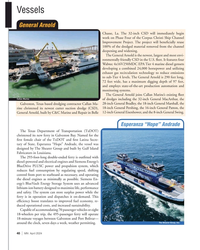 )
April 2024 - Marine News page: 40
)
April 2024 - Marine News page: 40Vessels General Arnold Chasse, La. The 32-inch CSD will immediately begin work on Phase Four of the Corpus Christi Ship Channel Improvement Project. The project will bene? cially reuse 100% of the dredged material removed from the channel deepening and widening. The General Arnold is the newest,
-
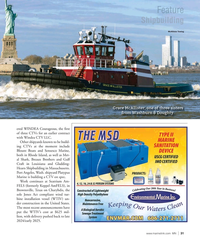 )
April 2024 - Marine News page: 31
)
April 2024 - Marine News page: 31McAllister Towing Grace McAllister, one of three sisters from Washburn & Doughty. ered WINDEA Courageous, the ? rst of three CTVs for an earlier contract with Windea CTV LLC. Other shipyards known to be build- ing CTVs at the moment include Blount Boats and Sensesco Marine, both in Rhode Island
-
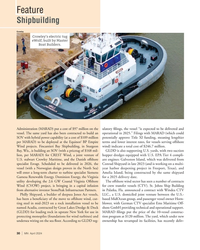 )
April 2024 - Marine News page: 30
)
April 2024 - Marine News page: 30Feature Shipbuilding Crowley Crowley’s electric tug eWolf, built by Master Boat Builders. Administration (MARAD) put a cost of $97 million on the ulatory ? lings, the vessel “is expected to be delivered and vessel. The same yard has also been contracted to build an operational in 2025.” Filings with
-
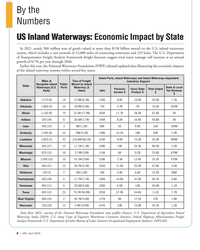 )
April 2024 - Marine News page: 8
)
April 2024 - Marine News page: 8By the Numbers US Inland Waterways: Economic Impact by State In 2021, nearly 500 million tons of goods valued at more than $158 billion moved on the U.S. inland waterways system, which includes a vast network of 12,000 miles of connecting waterways and 219 locks. The U.S. Department of Transportation
-
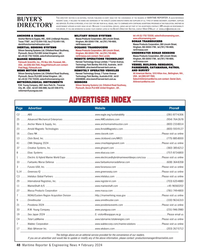 )
February 2024 - Maritime Reporter and Engineering News page: 48
)
February 2024 - Maritime Reporter and Engineering News page: 48Index page MR Feb2024:MN INDEX PAGE 2/8/2024 11:05 AM Page 1 ANCHORS & CHAINS MILITARY SONAR SYSTEMS tel:+44 (0) 1752 723330, [email protected] , www.siliconsensing.com Anchor Marine & Supply, INC., 6545 Lindbergh Houston, Massa Products Corporation, 280 Lincoln Street, SONAR TRANSDUCERS
-
 )
February 2024 - Maritime Reporter and Engineering News page: 22
)
February 2024 - Maritime Reporter and Engineering News page: 22Wabtec is huge, pervasive in power across in- the journey to your present position? dustries, but not broadly known globally in the I graduated from the University of Notre Dame with an maritime sector. Please give a ‘By the Numbers’ undergraduate in Mechanical Engineering and started with look at the company
-
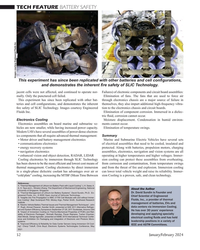 )
January 2024 - Marine Technology Reporter page: 52
)
January 2024 - Marine Technology Reporter page: 52Battery Pack with Liquid Cooling”; L.H. Sawa, A. A. O. Taya and L. Winston Zhang; The Department of Mechanical Engineering, National About the Author University of Singapore, Singapore Dr. David Sundin is Founder and 2. “Thermal Management of Lithium-Ion Battery Systems”, David Sundin, Ph.D. En- gineered
-
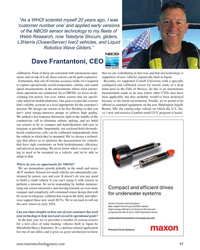 )
January 2024 - Marine Technology Reporter page: 49
)
January 2024 - Marine Technology Reporter page: 49. supportive of new vehicles organically built in Japan. Fortunately, that sort of extreme accuracy really isn’t required Recently, we supported Cornell University with a specially to capture operationally useful temperature, salinity, and sound con? gured and calibrated sensor for remote study of a deep
-
 )
January 2024 - Marine Technology Reporter page: 18
)
January 2024 - Marine Technology Reporter page: 18the path toward commercialization. By Greg Trauthwein To start us off, can you give us a by the numbers look at in Ocean Engineering at Oregon State University, which is Mocean Energy today? where I ? rst started working on Wave Energy. Next I went to Mocean Energy has been operating since 2016, today
-
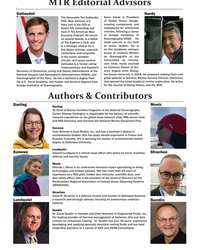 )
January 2024 - Marine Technology Reporter page: 6
)
January 2024 - Marine Technology Reporter page: 6of Commerce, acting and Deputy Administrator of the ence degree from Shang- National Oceanic and Atmospheric Administration (NOAA), and hai Ocean University in 2018. He proposed making thick wall Oceanographer of the Navy. He has a bachelor’s degree from glass spheres to Nautilus Marine Service/Vitrovex
-
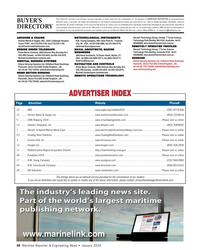 )
January 2024 - Maritime Reporter and Engineering News page: 48
)
January 2024 - Maritime Reporter and Engineering News page: 48Index page MR Dec24:MN INDEX PAGE 1/9/2024 4:37 PM Page 1 ANCHORS & CHAINS METEOROLOGICAL INSTRUMENTS Harvest Technology Group Limited, 7 Turner Avenue, Technology Park Bentley WA 6102, Australia , tel:61 Anchor Marine & Supply, INC., 6545 Lindbergh Houston, R.M. Young Company, 2801 Aero Park Dr.
-
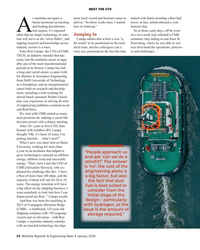 )
January 2024 - Maritime Reporter and Engineering News page: 24
)
January 2024 - Maritime Reporter and Engineering News page: 24most transformational periods in its history. Campe has had a long and varied career, a career with his Masters in Aerospace Engineering from Delft University of Technology as a foundation, and an entrepreneurial career built on research and develop- ment, including a stint working for famed Dutch astronaut
-
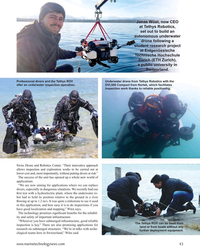 )
November 2023 - Marine Technology Reporter page: 43
)
November 2023 - Marine Technology Reporter page: 43to build an autonomous underwater drone following a student research project at Eidgenössische Technische Hochschule Zürich (ETH Zurich), a public university in Switzerland. Professional divers and the Tethys ROV Underwater drone from Tethys Robotics with the after an underwater inspection operation
-
 )
November 2023 - Marine Technology Reporter page: 42
)
November 2023 - Marine Technology Reporter page: 42Floor research project at Eidgenössische Technische Hochschule During Tethys Robotics’ ? rst discussions with Nortek, the Zürich (ETH Zurich), a public university in Switzerland. DVL500 Compact had just been released. This is a 500 kHz Tethys Robotics’ goal was to build an autonomous under- DVL in a small
-
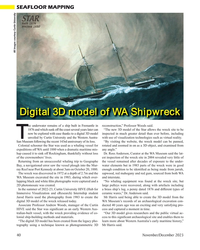 )
November 2023 - Marine Technology Reporter page: 40
)
November 2023 - Marine Technology Reporter page: 40SEAFLOOR MAPPING All images courtesy Curtin University Digital 3D model of WA Shipwreck he underwater remains of a ship built in Fremantle in reconstruction,” Professor Woods said. 1876 and which sunk off the coast several years later can “The new 3D model of the Star allows the wreck site to be now be
-
 )
November 2023 - Marine Technology Reporter page: 20
)
November 2023 - Marine Technology Reporter page: 20NATO Centre for Maritime Research and Experimentation undersea infrastructure, naval mine warfare, maritime security (CMRE) in La Spezia, Italy, the University of Porto’s Labo- operations, force protection, underwater warfare, amphibious ratory for Underwater Systems and Technology (LSTS), and operations
-
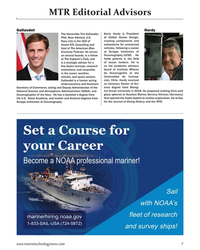 )
November 2023 - Marine Technology Reporter page: 7
)
November 2023 - Marine Technology Reporter page: 7of Commerce, acting and Deputy Administrator of the ence degree from Shang- National Oceanic and Atmospheric Administration (NOAA), and hai Ocean University in 2018. He proposed making thick wall Oceanographer of the Navy. He has a bachelor’s degree from glass spheres to Nautilus Marine Service/Vitrovex
-
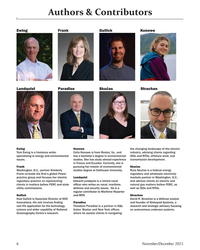 )
November 2023 - Marine Technology Reporter page: 6
)
November 2023 - Marine Technology Reporter page: 6and Ecuador. Currently, she is Frank pursuing her master of environmental Skucas Washington, D.C., partner Kimberly studies degree at Dalhousie University. Ruta Skucas is a federal energy Frank co-leads the ? rm’s global Power regulatory and wholesale electricity practice group and focuses her electric
